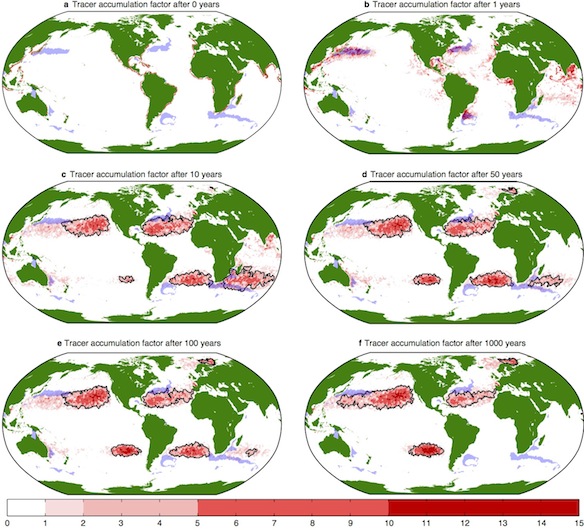Origin, dynamics and evolution of ocean garbage patches from observed surface drifters
Erik van Sebille, Matthew H England, and Gary Froyland
In Environmental Research Letters, volume 7, number 044040. doi:10.1088/1748-9326/7/4/044040.
In Environmental Research Letters, volume 7, number 044040. doi:10.1088/1748-9326/7/4/044040.
Abstract
Much of the debris in the near-surface ocean collects in so-called garbage patches where, due to convergence of the surface flow, the debris is trapped for decades to millennia. Until now, studies modelling the pathways of surface marine debris have not included release from the coasts nor factored in the possibility that release concentrations vary with region or that pathways may include a seasonal cycle. Here, we use observational data from the Global Drifter Program in a particle-trajectory tracer approach that includes the seasonal cycle to study the fate of marine debris in the open ocean from coastal regions around the world on interannual to centennial time scales. We find that six major garbage patches emerge, one in each of the five subtropical basins and one previously unreported patch in the Barents Sea. The evolution of each of the six patches is markedly different. With the exception of the North Pacific, all patches are much more dispersive than expected from linear ocean circulation theory, suggesting that on centennial time scales the different basins are much better connected than previously thought and that inter-ocean exchanges play a large role in the spreading of marine debris. This study suggests that, over multi-millennial time scales, a significant amount of the debris released outside of the North Atlantic will eventually end up in the North Pacific patch, the main attractor of global marine debris.
Movies (see also www.youtube.com/user/erikvansebille)
Interview with UNSWtv on the formation of the great ocean garbage patches, discussing the implications of our paper Van Sebille, England, and Froyland (2012), Origin, dynamics and evolution of ocean garbage patches from observed surface drifters, Environ. Res. Lett., in press. [ abstract | pdf ]
As this work has been funded by the Australian Research Council, the most important component of it - the set of tracer transit matrices - is freely downloadable here. If you use the Matrix, please cite the paper (see above).

The Ocean Tracer Transit Matrix is licensed under a Creative Commons Attribution 3.0 Unported License.
![]() Download the Ocean Tracer Transit Matrix (8MB)
Download the Ocean Tracer Transit Matrix (8MB)
Open the matrix in MATLAB® or Python with NumPy/SciPy.
The sparse matrices P and their use are described in the paper.

The Ocean Tracer Transit Matrix is licensed under a Creative Commons Attribution 3.0 Unported License.
Key figure

Figure 1: The locations and sources of the six garbage patches. a) The Tracer Accumulation Factor (TAF) at the moment of release. Coastal population is used as a proxy for the amount of tracer released. The blue patches denote areas where Sea Surface Height variability is larger than 15 cm, an indication of high eddy activity. Note that in these figures, as well as in the video in the supplementary material, white shading means that the Tracer Accumulation Factor (TAF, see also the methods section) is less than 1. b) The TAF after 1 year of integrating the tracer. The tracer is advected into the open ocean by the swift-flowing surface currents. c) The TAF after 10 years of integrating the tracer. Well-defined patches can be seen in each of the five subtropical gyres. The thick lines denote the spatial extent of the patches. d) The TAF after 50 years of integrating the tracer. The Southern Indian patch has become much smaller, while the Southern Pacific one has grown considerably in comparison to the tracer density after 10 years. A sixth patch is now visible in the Barents Sea. e) The TAF after 100 years of integrating the tracer. The patch in the South Indian has almost completely disappeared. f) The TAF after 1,000 years of integrating the tracer. The patches in the Southern Atlantic and Indian have completely disappeared, and the patches in the South and North Pacific have grown considerably in size.
This article was first published in Environmental Research Letters by IOP Publishing, which maintains the Version of Record.